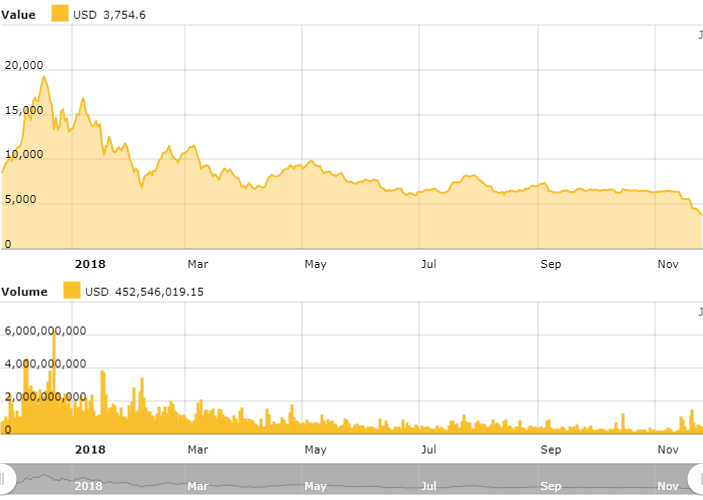When bitcoin had been trading at $20,000 in December last year, people had become divided into two camps: the bitcoin bulls who said that bitcoin’s rise had only begun, and predicted that bitcoin could touch $100,000 by the end of the year. At the same time, bitcoin skeptics had maintained that bitcoin was one of the biggest bubbles in history, and its prices would come crashing down. Less than a year later, bitcoin’s price moves have decisively shown one set of people to be right.
Bitcoin has now lost more than 80% of its value since the peak it had touched in December last year. Bitcoin today trades at $3,463, down from the high of $20,00 at which it was being traded just over 10 months ago. The fall in bitcoin’s price hasn’t been as sudden as some bitcoin bears had expected, but it has been persistent — by January, bitcoin was trading at $15,000, and by March it had fallen to $8,000. Bitcoin found support at the $6,000 levels for a while — bitcoin traded in that range from June to November.

But the last 10 have seen bitcoin lose nearly half its value — Bitcoin has crashed from the $6000 levels to $$3,500 over the period. The latest crash hasn’t had an apparent cause, apart from a fork in Bitcoin Cash which occurred last week. One theory for bitcoin’s price decline says that with two groups of developers associated with Bitcoin cash are furiously mining blocks on their respective blockchains to establish control, which has required them to liquidate their bitcoin reserves to finance their operations.
However the turbulence in bitcoin cash notwithstanding, bitcoin hasn’t quite lived up the promise that evangelists had been touting in 2017. Its acceptance rates are still low — earlier this year, a bitcoin conference had stopped accepting payments in bitcoin because they were expensive and took time to process. Meanwhile, concerns have also been raised about the real costs of using bitcoin — a single bitcoin transaction can need enough electricity as to power a house for an entire week. And world governments — India included — have been cracking down on bitcoin has its popularity and profile has risen.
With the latest crash, it’s becoming increasingly apparent that bitcoin’s lost its moment. Just over a year ago, it was everywhere, being talked about on TV, hotly debated in restaurants, and becoming a topic of conversation at family dinner tables. With it having lost nearly 80% of its value over the period, it’s lost much of the buzz around it as well — bitcoin’s fallen nearly 40% in the last 10 days, but there have been no screaming headlines, no dramatic news reports, and no predictions of doom. With this latest bitcoin crash, the world has watched on with a sense of inevitability. And this relative disinterest might just be a portent of the final nail being driven into bitcoin’s coffin.
